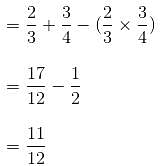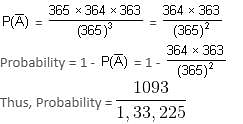Test Level 1: Probability - 2 - CAT MCQ
20 Questions MCQ Test - Test Level 1: Probability - 2
What are the odds against drawing 2 red balls from a bag containing 3 red and 2 white balls?
Three unbiased coins are tossed. What is the probability of getting at most two tails?
| 1 Crore+ students have signed up on EduRev. Have you? Download the App |
In a single throw of two dice, find the probability that neither a doublet nor a total of 10 will appear.
The number lock of a suitcase has 4 wheels, each labelled with ten digits, i.e. from 0 to 9. The lock opens with a sequence of four digits with no repeats. What is the probability of a person getting the sequence to open the suitcase?
Three dice are rolled together. What is the probability of getting the same number on the three?
In a class, there are 15 boys and 10 girls. Three students are selected at random. Find the probability that 1 girl and 2 boys are selected.
Two dice are thrown. Find the probability that the product of two numbers received is even.
A biased coin is tossed 700 times. Heads appears 300 times and tails appears 400 times. If the coin is tossed again, the probability of getting heads is
The probability that A can solve a problem is 2/3 and the probability that B can solve the problem is 3/4. The probability that at least one of A and B will be able to solve the problem is
There are 20 pens in a bag. 4 pens are defective. Two pens are chosen at random from the bag. The probability that at least one of these is defective is
The chances of winning of two race horses are 1/3 and 1/6. What is the probability that at least one will win, if the horses are running in different races?
What is the probability of getting a sum of 6 from two throws of a dice?
A coin is tossed five times. Find the probability of getting 2 heads and 3 tails.
A bag contains 6 white and 9 black balls. If three balls are drawn at random, then find the probability that all of them are black.
Two dice are rolled simultaneously. Find the probability of getting a multiple of 2 on one die and a multiple of 3 on the other die.
The letters of the word 'LEADING' are placed at random in a row. What is the probability that three vowels come together?
The probability that in a group of 3 people, at least two will have the same birthday is
In throwing a fair dice, what is the probability of getting the number ‘3’?
Find the chance of throwing at least one ace in a simple throw with two dice.
From a pack of 52 cards, two are drawn at random. Find the chance that one is a knave and the other a queen.































